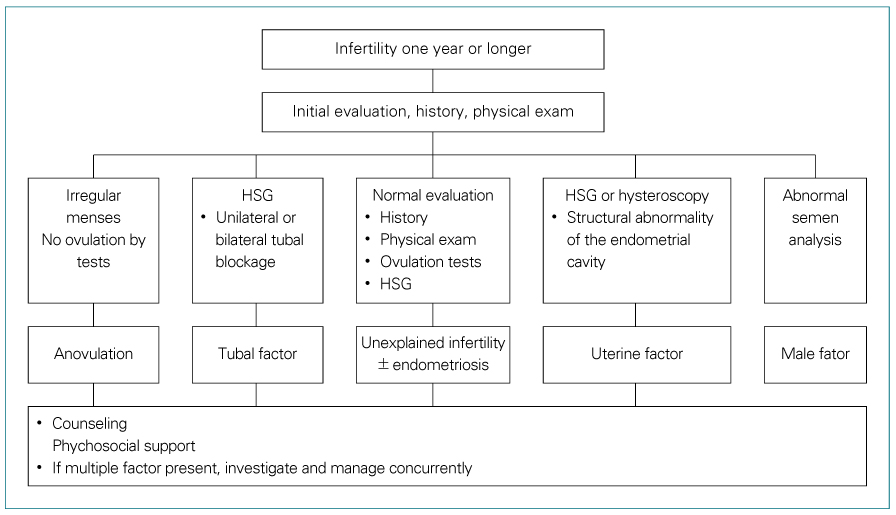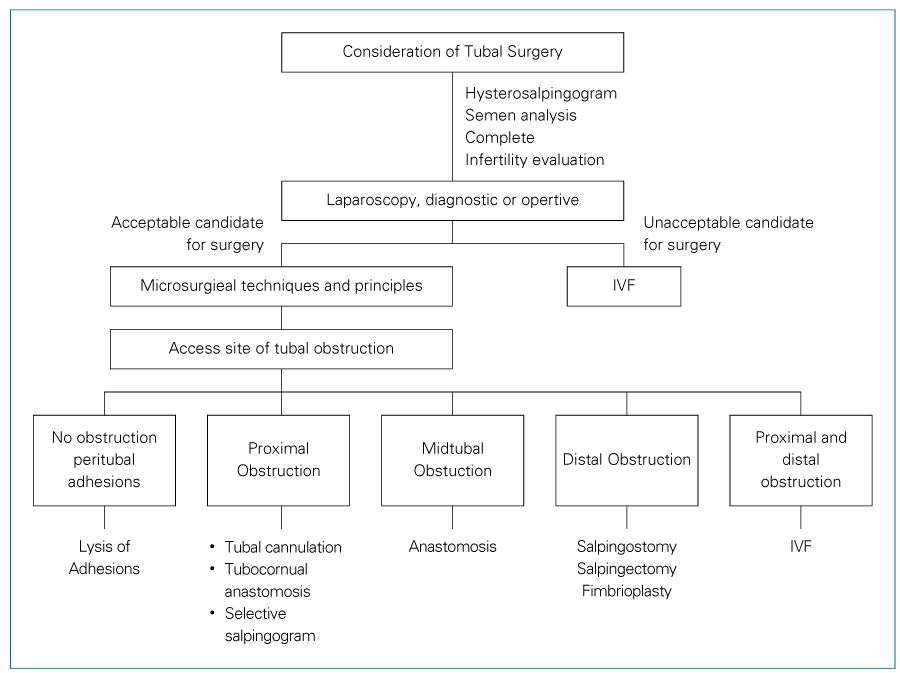J Korean Med Assoc.
2003 Sep;46(9):825-832. 10.5124/jkma.2003.46.9.825.
Female Infertility
- Affiliations
-
- 1Department of Obstetrics and Gynecology, Pochun Cha University College of Medicine, Kang-nam Cha Hospital, Korea. tkyoon@cha.ac.kr, ynaey@hanmail.net
- 2Infertility Medical Center, Pochun Cha University College of Medicine, Kang-nam Cha Hospital, Korea.
- KMID: 2183123
- DOI: http://doi.org/10.5124/jkma.2003.46.9.825
Abstract
- Infertility is a disease that exists when a couple has tried to conceive for 12 months during which time they have had intercourse without the use of contraception. The fecundability of a normal couple in one cycle has been estimated at 20% to 25%. On the basis of this estimate, about 85% of couples should conceive after 12 months of unprotected intercourse. Infertility affects about 13.5% of reproductive couples in Korea. Earlier evaluation and treatment is required in women with age over 35 years and some medical conditions. Both partners should be evaluated at the same time. The use of a standard infertility treatment algorithm results in a higher pregnancy rate and lower cost and therefore should be the preferred treatment approach. IVF-ET and tubal surgery must be considered to be complementary rather than competitive procedures. Adequate selection of patients is crucial to find the best therapeutic approach.
Keyword
MeSH Terms
Figure
Reference
-
2. Mosher WD, Pratt WF. Fecundity and infertility in the United States : incidence and trends. Fertil Steril. 1991. 56:192–193.3. Wathen NC, Perry L, Lilford RJ, Chard T. Interpretation of single progesterone measurement in diagnosis of anovulation and defective luteal phase : observations on analysis of the normal range. Br Med J (Clin Res Ed). 1984. 288:7–9.
Article4. Jordan J, Craig K, Clifton DK, Soules MR. Luteal phase defect : the sensitivity and specificity of diagnostic methods in common clinical use. Fertil Steril. 1994. 62:54–62.
Article5. Batista MC, Cartledge TP, Merino MJ, Axiotis C, Platia MP, Nieman LK, et al. Midluteal phase endometrial biopsy does not accurately predict luteal function. Fertil Steril. 1993. 59:294–300.
Article6. Sharara FI, Scott RT Jr, Seifer DB. The detection of diminished ovarian reserve in infertile women. Am J Obstet Gynecol. 1998. 179:804–812.
Article7. Glatstein IZ, Harlow BL, Hornstein MD. Practice patterns among reproductive endocrinologists : further aspects of the infertility evaluation. Fertil Steril. 1998. 70:263–269.
Article8. Schwarzler P, Concin H, Bosch H, Berlinger A, Wohlgenannt K, Bourne TH, et al. An evaluation of sonohysterography and diagnostic hysteroscopy for the assessment of intrauterine pathology. Ultrasound Obstet Gynecol. 1998. 11:337–342.
Article9. Ubaldi F, Wisanto A, Camus M, Tournaye H, Clasen K, Devroey P. The role of transvaginal ultrasonography in the detection of pelvic pathologies in the infertility workup. Hum reprod. 1998. 13:330–333.
Article10. Pirwany Imran, Tulandi Togas. Laparoscopic treatment of polycystic Ovaries : is it time to relinquish the pro edure? Fertility and Sterility. 2003. 80:241–251.
Article11. Posaci C, Camus M, Osmanagaoglu K, Devroey P. Tubal surgery in the era of assisted reproductive technology : clinical options. Human Reproduction. 1999. 14:120–136.
Article12. Puttemans P, Campo R, Gordts S, Brosens I. Hydrosalpinx-functional surgery or salpingectomy? Hum Reprod. 2000. 15:1427–1430.13. Johnson NP, Mak W, Sowter MC. Laparoscopic salpingectomy for women with hydrosalpinges enhances the success of IVF. Hum Reprod. 2002. 17:543–548.14. Yoon TK, Sung HR, Kang HG, Cha SH, Lee CN, Cha KY. Laparoscopic tubal anastomosis : fertility outcome in 202 cases. Fertil Steril. 1999. 72:1121–1126.15. Goldberg JM, Falcone T. Laparoscopic microsurgical tubal anastomosis with and without robotic assistance. Hum Reprod. 2003. 18:145–147.
Article16. Fatum M, Laufer N, Simon A. Should diagnostic laparoscopy be performed after normal hysterosalpingography in treating infertility suspected to be of unknown origin? Hum Reprod. 2002. 17:1–3.17. Karande VC, Korn A, Morris R, Rao R, Gleicher N, et al. Prospective randomized trial comparing the outcome and cost of in vitro fertilization with that of a traditional treatment algorithm as first-line therapy for couples with infertility. Fertility and Sterility. 1999. 71:468–475.
Article
- Full Text Links
- Actions
-
Cited
- CITED
-
- Close
- Share
- Similar articles
-
- Causes and Diagnosis of Female Infertility
- Causal association of cathepsins with female infertility: a bidirectional Mendelian randomization analysis
- Genetic Causes in Male Infertility and Current Studies on Infertility Genes
- Factors Affecting the Infertility-Related Quality of Life among the Infertility Women
- A Study on the Case Rate of Chest Tuberculosis in Female Infertility



